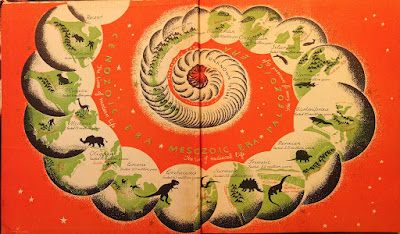Here's a find from Second Editions Books in Butte, Montana (recommended the next time you're in Butte!): The Earth Changes by Jannette May Lucas with art by Helene Carter.
Lucas's text is fine for the 1937 publication date, but it's the art that makes the book memorable. Starting with the cover...

...and continuing to the dynamic end papers. (Click any of the images to enlarge, but this one is particularly worth it):

The title page, like all of the display text, is completely hand-lettered, with the green second ink color creating a pattern of early life forms:

Each era has a map of the continents showing their current outline, compared with what the land and water were like then:

Spot illustrations are used throughout, usually in one or two colors:



(Yes, there were dragon flies with a wing spread of twenty inches.)
Not to mention the initial capital letters, some in black-only like this one, some in two colors:

Helene Carter was a Canadian artist and illustrator, born in 1887, who worked in advertising in New York City in the 1920s. While there, she got to know the naturalist and herpetologist Raymond Ditmars and came to love natural history. From the mid-1930s on, she illustrated a number of nonfiction children's books on topics like insects, prehistoric animals, plants, and flowers.
Her work in The Earth Changes reminds me of Virginia Lee Burton's art, and especially her book Life Story, which came out about 10 years later. I wonder if they knew each other?
Carter's original art and papers (except The Earth Changes, unfortunately) are collected at the University of Minnesota's Kerlan Collection. I especially want to check out Where Does Your Garden Grow? and The Gulf Stream.
Tuesday, July 5, 2016
The Earth Changes
Subscribe to:
Post Comments (Atom)


2 comments:
What a beautiful find. I like the way Unknown Time resembles a gelatin mold or bundt cake. Interesting that the writer thinks of coal as soon being a thing of the past.
I saw that same mention of coal soon being a thing of the past. I'll bet there was some "peak coal" thinking going in the late 1930s, well before mountaintop removal was even a gleam in some coal baron's eye.
Post a Comment